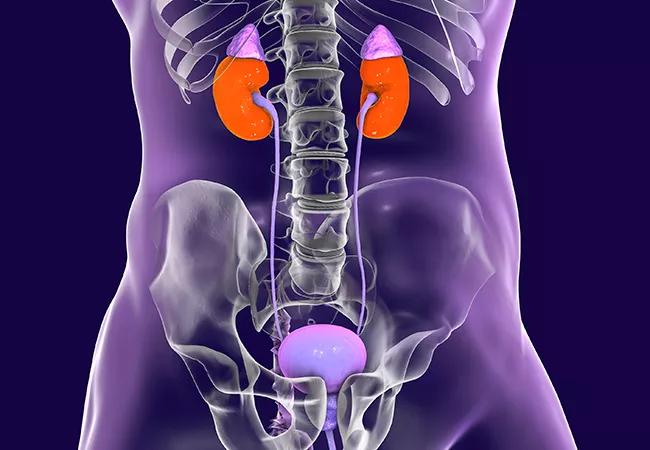A Cleveland Clinic specialist discusses the implications of the first published guideline for NLUTD

In 2021 the American Urological Association (AUA) and the Society of Urodynamics, Female Pelvic Medicine and Urogenital Reconstruction (SUFU) released a joint clinical guideline for comprehensive management of neurogenic lower urinary tract dysfunction (NLUTD) in adults.
Advertisement
Cleveland Clinic is a non-profit academic medical center. Advertising on our site helps support our mission. We do not endorse non-Cleveland Clinic products or services. Policy
There are 60 recommendations in total, but the key highlights focus on leading an initial risk-stratifying assessment to guide care plan strategies, managing autonomic dysreflexia, considerations for urinary tract infection (UTI) management, and treatment options to improve bladder storage function.
This is the first published guideline about the condition, which has previously been referred to as “neurogenic bladder.” The AUA/SUFU guideline also indicates that neurogenic lower urinary tract dysfunction is the preferred terminology for the condition because it more accurately localizes the voiding issue, which is not solely confined to the bladder.
“It’s not necessarily a bladder problem,” explains Emily Slopnick, MD, a female pelvic medicine and reconstructive surgeon at Cleveland Clinic. “It could be an outlet problem related to the urinary sphincter, or any dysfunction in the lower urinary tract.”
There is significant variability in the dysfunction itself and the underlying causes. While NLUTD is most commonly related to multiple sclerosis and spinal cord injury, it could also be associated with Parkinson’s disease, stroke, or an advanced effect of diabetes—and could also vary based on the effect of any one of these pathologies on a patient’s nervous system.
“Management strategies will vary based on whether the brain and spinal cord are affected, for example, versus nerve involvement in the pelvis. Some people may have a problem with urinary retention, others with urinary incontinence, and some may have both. How the dysfunction is treated really depends on what the problem is,” she says.
Advertisement
Because of this, one of the most notable themes in the guideline is properly evaluating risk.
“Conditions with retention or significant pressure in the bladder can lead to impaired kidney function, so our number one priority is to protect the kidneys,” she notes. “Other sequelae include UTIs, bladder stones and, of course, quality of life.”
About 10% to 20% of Dr. Slopnick’s practice includes treating patients with NLUTD. In an older NLUTD patient population, it can be difficult to decipher whether certain symptoms are associated with the disease or if it’s associated with a natural weakening of lower urinary tract muscles. This underscores the importance of careful evaluation to guide surveillance and treatment approaches.
The AUA/SUFU guideline is also an opportunity to codify nonsurgical and surgical treatment options and reflect updated approaches, which, in some cases, have expanded in recent years because of new evidence or technology.
For example, indications have only recently included sacral neuromodulation devices as a possible treatment option for patients with NLUTD because the technology was previously not compatible with an MRI, essential to neurologic care.
Dr. Slopnick says the multidisciplinary nature of care at Cleveland Clinic helps facilitate collaboration with other specialists and subspecialists when issues arise in the management of NLUTD. The team may work with the patient’s neurologist to understand the disease process and whether it’s a progressive or stable pathology. They may also work with colleagues in gastroenterology to manage coexisting neurogenic bowel symptoms, including severe constipation and/or fecal incontinence.
Advertisement
“There’s such huge variability in this patient population, including their functional status – whether or not that they can catheterize themselves, as an example. All of this impacts how we manage their care,” says Dr. Slopnick.
“Someone who has MS with mild symptoms of overactive bladder will be managed very differently from someone who has quadriplegia because of a spinal cord injury, though both patients have NLUTD. The guideline reinforces the nuance of the dysfunction and helps us individualize care.”
Advertisement
Advertisement

Reproductive urologists publish a contemporary review to guide practice

Two recent cases show favorable pain and cosmesis outcomes

Meta-analysis assesses outcomes in adolescent age vs. mid-adulthood

Proteinuria reduction remains the most important treatment target.

IgA nephropathy is a relatively common autoimmune glomerular disease that can be diagnosed only by biopsy

Oncologic and functional outcomes are promising, but selection is key

Cleveland Clinic is first to use the device, known formerly as the UroMonitor

First single-port renal vein transposition reduces recovery time and improves outcomes